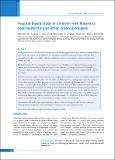Please use this identifier to cite or link to this item:
https://hdl.handle.net/20.500.14356/1924| Title: | Hospital-Based Study in Children with Rotavirus Gastroenteritis and Other Enteropathogens |
| Authors: | Sherchand, J B Tandulkar, S Sherchan, J B Gurung, B Rayamajhi, A Shrestha, L Rijal, B Pokhrel, B M |
| Citation: | SherchandJ. B., TandulkarS., SherchanJ. B., GurungB., RayamajhiA., ShresthaL., RijalB., & PokhrelB. M. (2012). Hospital-Based Study in Children with Rotavirus Gastroenteritis and Other Enteropathogens. Journal of Nepal Health Research Council. https://doi.org/10.33314/jnhrc.v0i0.321 |
| Issue Date: | 2012 |
| Publisher: | Nepal Health Research Council |
| Article Type: | Original Article |
| Keywords: | Enteropathogens Gastroenteritis Genotyping Rotavirus |
| Series/Report no.: | May-Aug, 2012;321 |
| Abstract: | Abstract Background: Rotavirus is the most common cause of life threatening gastroenteritis in infants and young children in the world. The objective of the study is to find out current trends and incidents of rotavirus, including other enteropathogens related with children diarrhoea and lastly identify the most common rotavirus serotypes that circulate in Nepal. Methods: A total of 1721 stool samples from less than 5 years of children were collected. Rotavirus in the stool samples were detected by Enzyme Immuno Assay (EIA) and strains were genotyped by Reverse-Transcription Polymerase Chain Reaction (RT-PCR). Bacteria and parasites were detected by following standard microbiological procedures. Results: In between 2009 to 2010, of the total 1721, the prevalence of rotavirus was 24.7%. Of them, 906 (52.6%) were collected in the year 2009 and 815(47.5%) in the year 2010.  Rotavirus was frequently detected in inpatients (31.6%) than outpatient (16.8%). Rotavirus detection was higher in female (26.4%) than male (23.7%). The prevalence was seen higher in age group 0-23 months in both years. Among six different bacterial isolates, Escherichia coli was most frequently isolated (6.5%). Similarly, Giardia lamblia (1.3%) was most common among six different parasites detected. A total of rotavirus positive 425 stool samples were detected over 2 years (2009-230, and 2010-195), G12P6 was the predominant strain circulating in both (45% in 2009 and 28% in 2010) years. G9P6 emerged in 2010 (6%). There were significant numbers of mixed infections (14.0% in 2009 and 29.8% in 2010). Thirty five samples were partially typed and 15 were completely untyped over the two year period. Conclusions: The study helps comprehend the prevalence of rotavirus along with other intestinal pathogens including bacteria and parasites. Major genotypes of rotavirus are also introduced in the study Keywords: enteropathogens; gastroenteritis; genotyping; rotavirus. |
| Description: | Original Article |
| URI: | http://103.69.126.140:8080/handle/20.500.14356/1924 |
| ISSN: | Print ISSN: 1727-5482; Online ISSN: 1999-6217 |
| Appears in Collections: | Vol 10 No 2 Issue 21 May - Aug, 2012 |
Files in This Item:
| File | Description | Size | Format | |
|---|---|---|---|---|
| 321-Article Text-320-1-10-20130823.pdf | Fulltext Download | 502.64 kB | Adobe PDF |  View/Open |
Items in DSpace are protected by copyright, with all rights reserved, unless otherwise indicated.
